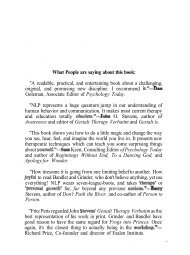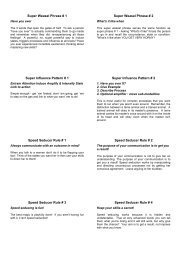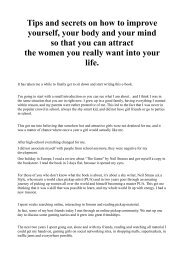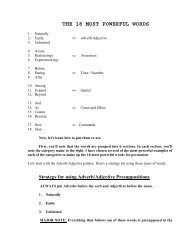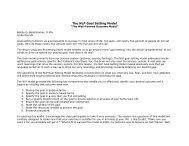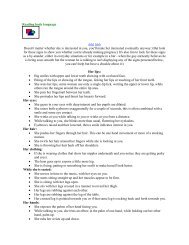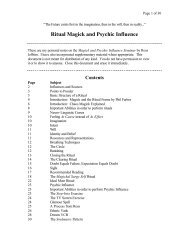A Pragmatic Guide To Communication & Change.pdf - NLP Info Centre
A Pragmatic Guide To Communication & Change.pdf - NLP Info Centre
A Pragmatic Guide To Communication & Change.pdf - NLP Info Centre
- No tags were found...
You also want an ePaper? Increase the reach of your titles
YUMPU automatically turns print PDFs into web optimized ePapers that Google loves.
the communication process.<br />
The contradiction between the two rules for listening has many ramifications. How often<br />
have you encountered or participated in the scene illustrated below in which the angry<br />
adult takes the child's chin in hand, saying, "Look at me when I'm talking to you!"? This<br />
is often an example of conflict between the look-to-listen and must-look-away rules.<br />
In stressful situations, "digitals" and "tonals" are usually less comfortable trying to<br />
understand what is being said to them if they are being "forced" to make eye contact. This<br />
is also generally true for someone operating out of the kinesthetic model. What these<br />
people see distracts their<br />
58<br />
actually touch the people they are talking with. Just as the "visual" gains information<br />
about a speaker by observing subtle movements, muscular tension and relaxation, the<br />
"kino" gains the same information through touch and close proximity. Though people<br />
operating out of either of the systems have the ability to use any representational system,<br />
they will tend to rely upon their preferred system for most of their information.<br />
As you can imagine, there is great potential for discomfort and miscommunication<br />
between two individuals communicating from these two different communication<br />
categories. Where the "visual" needs distance so as to get a "clear picture" of the process,<br />
the "kino" wants to get close enough to insure a "good connection." However, the<br />
moment the "kino" pushes past the comfortable distance range for the "visual," the<br />
"visual" goes into stress. This stress is communicated - usually analogically through a<br />
tightening of the skeletal muscles and a strain in the voice tonality- to the "kino" who<br />
responds by also going into stress. Of course, in the stress situation, the "kino" will want<br />
even more "contact," and the demands for closeness increase resulting in even more stress<br />
for the "visual."<br />
The processes described above all go on almost totally outside the awareness of the<br />
individuals involved. This is a common pattern found in couples who come in for counsel<br />
ing. The results are often verbalized in the following way:<br />
Husband: "I never feel as if we have really connected, especially when we argue. I feel<br />
like there's a great distance between us."<br />
Wife: "He never seems to get the whole picture. He's always invading my space and<br />
`pawing' at me while we're trying to have a serious conversation."<br />
(Of course, these roles are just as often reversed.)<br />
Anthropologist Edward Hall, previously cited, has noticed similar patterns within whole<br />
cultures. In one article, Hall<br />
59<br />
points out that of the cultures he has studied, the Arabs prefer a ,inch closer<br />
"conversational distance" than any of the others, especially compared to the typical<br />
"American." His description of their behaviors is an interesting blend of social constraints<br />
(see Chapter I) and representational systems.<br />
Overall, what they're doing is coding, sort of synthesizing, their reactions. They<br />
say to themselves, "How do I feel about this person?" In contemporary American<br />
terms: "What kind of vibes am I getting from him?" They are also responding to<br />
smell and to the thermal qualities of the other person. We talk about someone<br />
with a warm personality. This is literally true, and there is [also] a very cold fish.<br />
This is the person who draws heat from you. So they're picking up thermal,







